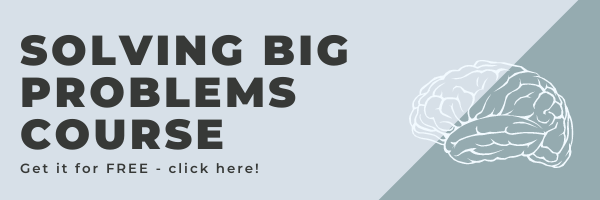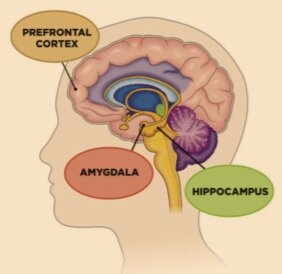The Decision Maker of your Emotional Brain: Introducing the Amygdala
...AKA the tiny, little almond-like figures (there are 2) in the central part of the brain.
Tiny, but MIGHTY!
We did talk about the Amygdala in passing when we were looking at parts of the Limbic System AKA barking dog. Today, we dive deeper and have a microscopic look into the amygdala.
One of my FAVORITE areas to chat about because it’s the decision maker of the emotional brain.
Have you ever encountered situations where your usual coping mechanisms couldn’t control your response to stress? Or had some moments that trigger negative events? Then, you feel the onset of shortness of breath, anxiety, and heart palpitations. Guess what? I have too, and frankly speaking, I was a bit disappointed in myself.
Why? Well, for one I study this stuff, and two because I am a look-on-the-bright-side kind of person, a positive vibe spreader, an overcomer. When I am down, I take a detailed look at my life to pinpoint the problem. If I feel tired, I do some yoga or meditate. And if I need to talk, I reach out to my amazing mother or friends for some R&R.
You get why the epiphany took me by surprise. I mean, I have learned how to regulate my emotions and self-soothe so how could I be out of control? I’d look at myself in the mirror and say:
We are better than this. We are funny and positive. The life force of the emotional party! Not the sad, panic attack, heart-pounding girl.
But still, the psychological reactions my body was having to these “triggers” refused to be shaken off. This still happened despite my best efforts to tell myself we are winning and we are in control. My go-to self-help strategies were losing the war against the visceral images flashing through my mind.
If you’ve been through this, you aren’t alone. There is a scientific explanation as to why you couldn’t get over it. It all boils down to the amygdala.
Lovely little thing, isn’t it?
What is the Amygdala?
It is made up of two almond-shaped nuclei situated smack in the middle of the emotional brain/central part of the brain.
I call it the “jumpy superhero” as it tries to protect you at all costs. It can mistake stress as an actual threat to the extent of preventing the PFC (prefrontal cortex) from doing its job.
But why would our fancy brains do something like that?
Well, the amygdala is responsible for our fight, flight, freeze, and fawn response.
So, during stressful moments, we get disconnected from rational thinking and shift to impulsive reactions (like fight, flight, freeze, or fawn). We lose connection with the upstairs brain functions like memory, mental flexibility, and self-regulation. So, we have a difficult time focusing, controlling impulses, remembering instructions, and making smart decisions. As a result, whenever we face strong emotions like anger or fear, the amygdala believes we are in danger and sounds the alarm.
Imagine what that might be like if you were a child who didn’t have a fully developed prefrontal cortex/thinking brain.
HELLO “problem” behaviors!
Kiddos may resort to impulsively hitting another kid. Or as parents, you might yell at your kiddos. Thanks amygdala for tricking us into believing we’re in danger.
It gets super hard to make smart decisions and speak rationally when your body is forcing you to bolt, fight, freeze, or fawn. Right?
An article was written by Susan Barry in Psychology Today and reported:
“The amygdala is involved with our experience of fear…one function of the amygdala may be to assign significance to experiences, particularly those that are frightening and life-threatening, and then to enhance the ability of other brain regions to consolidate memories of those event…the selective nature of our memory makes sense; our very survival may depend upon learning the lessons from life-threatening episodes.
However, our ability to selectively remember traumatic episodes can also harm us. Seven percent of the general population suffers from Post-Traumatic Stress Disorder (PTSD). Episodes which produce intense fear can lead to PTSD with effects that may last for a month or persist for a lifetime. Situations that remind the individual of the traumatic event or events can trigger an excessive release of stress hormones and over-activation of the amygdala which further augments stress hormone release. The result is severe emotional distress, racing thoughts, anger, and hyper-vigilance.”
What can we do?
In some way, it’s not anyone’s fault when it happens. But how can we rise above it and practice emotion regulation and mindfulness?
Several studies have shown that mindfulness helps activate and strengthen the PFC and the hippocampus, reducing the amygdala activation. Practicing mindfulness soothes the amygdala. Also, studies have proven that mindful people have a smaller amygdala. WE WANT THAT!
As parents and educators, we can help our kiddos achieve self-regulation using a mindful approach. Teach kiddos how to calm the amygdala and explain the importance of doing that. It can be done by having a few minutes of deep breathing, practicing sensory-motor strategies, exercises, or progressive muscle relaxation.
This way, our kiddos will:
Manage and respond to thoughts and emotions
Control their impulses
Control their attention
Pretty cool, right?
The even cooler thing is that it works the same way for us as adults. Make that mindfulness, meditation, and/or yoga a daily practice, and you'll find yourself thinking more clearly and acting more rationally.
So, whenever the amygdala shouts the alarm, the PFC will always be like, “Chill! We’ve got it handled.”
As always, if you ever have questions, please contact me. I’m here to help!
Questions? Need help? Reach out!
Email: hello@thebehaviorhub.com
Social media: @thebehaviorhub
Online school
Schedule a discovery call








